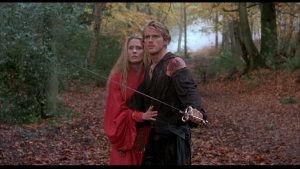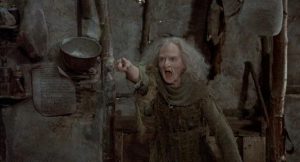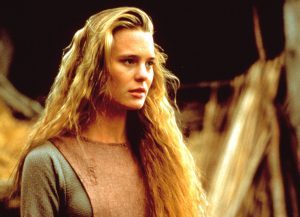As Men Wish
Just about everyone in liberal circles knows that the classic Disney princess movies are problematic. Even Disney knows it! The old classics that I grew up with—Cinderella, The Little Mermaid, Snow White and the Seven Dwarves, etc.—are condemned today for the female characters’ lack of agency and the overemphasis on physical beauty. According to one critic, the Disney Princess brand “implies that girls should be sweet and submissive” and suggests that “a girl’s most valuable asset is her beauty,” and these claims are backed up with data (Hains). After years of profiting off of the popularity of such movies and all of the many products surrounding them, Disney is trying to shake things up. Recent hit Disney princess movies include Frozen, Tangled, Brave, Moana, and others. These newer iterations of the classic fairy tale genre are trying to quell parents’ fears of misogynistic movies by creating stories with strong female characters and less emphasis on princes. Whether or not Disney succeeds in making feminist princess fairy tales (hint: they don’t), there seems to be demand for fairy tale movies that don’t reinforce patriarchal values. In a genre dominated by Disney, is there anything better out there?
Ernst Bloch, a Marxist philosopher who studies culture, would say there is. In fact, he thinks most of culture is better than what Disney has to offer. Bloch believes that pop culture is utopic—it helps viewers, readers, and audiences imagine what a better world might look and feel like. He isn’t referring to just stories in the utopic genre; he’s referring to just about every work of culture. That definitely includes fairy tales. And maybe that isn’t so surprising, after all, many fairy tales end with “and they all lived happily ever after.” Even adults frequently talk about a good outcome as a “fairy tale ending.” These tropes indicate that the world that fairy tales describe is happier and better than the world we live in. As Ernst puts it, fairy tales describe “a more colourful or lighter Elsewhere” where “there is enough happiness to go around” (Bloch, 353). According to Bloch, fairy tales respond to real social problems, so, for example, “when the peasant was still in bondage, the poor fairytale boy thus won the king’s daughter” (Bloch, 354). Present day fairy tales, therefore, ought to respond to current social problems as well. It’s been well established that Disney movies are not utopic; they reproduce problems in society, rather than solve them. But Disney’s princesses are not the only ones out there. The Princess Bride would like to be an alternative to Disney. It presents itself as a newly utopic fairy tale that differs from the misogyny of other fairy tale movies.
The Princess Bride styles itself as a self-aware, self-mocking fairy tale, but does so with a lot of love for the genre. The 1987 film situates itself in the fairy tale genre with its familiar storyline and characters such as the beautiful princess, the friendly giant, the master swordsman, and of course, the charming, clever, blond hero. Framed as a grandfather reading a story to his sick grandson, the main story describes a beautiful blond, who is kidnapped and later held captive, only to be rescued twice by the hero, who overcomes numerous obstacles and even death to save her, his true love. Though the plot is a classic one, the movie’s tones and humor aim to make it freshly utopic. The trailer advertises it as “not just your basic, average, everyday, ordinary, run-of-the-mill, ho-hum, fairytale.” The Princess Bride is funny and sharp and includes such self-ridiculing moments as when a Yiddish-singing miracle worker describes true love as second only in worth to a MLT—mutton, lettuce, and tomato sandwich. It takes fairy tale tropes to excess. When two of the heroes first meet as foes, they go to excesses of chivalry and have friendly conversations as they duel. One pulls the other up from a cliff’s edge and allows him time to rest while they have a friendly chat before they begin their fight to the death. These fresh, humorous moments are what fans love about the film. The comedic and parody elements have made The Princess Bride in the cult classic and reveal The Princess Bride’s intentions to be a utopic fairy tale.
Another key element that reveals the utopic aspirations of The Princess Bride is the commentary between the young boy and his granddad, who are reading the main story together while the grandson is sick. Though the young boy is initially wary of his grandfather’s book, he becomes very invested and interrupts the story to tell his grandfather that the story has gone wrong when it appears to be leading to an unhappy ending. He’s absolutely positive about how this fairy tale is supposed to be, and in the end he turns out to be right. He knows what a fairy tale happy ending looks like. He affirms the correctness of the morals of the story and of its definition of a happy ending. The movie draws the line between reality and fantasy, and the characters in reality approve of fantasy. This is most apparent at the end when the grandpa answers the boy’s request to hear the story again with the iconic phrase repeated by the hero, Westley to the heroine, Buttercup—“as you wish.” The ending unifies reality with story and affirms the message of love that the movie has been putting forth the entire time. Although it has been making fun of the princess genre and the trope of true love, the movie ends by blurring the lines of reality and fiction, thus endorsing the movie and the values that come with it. The purpose of these deviations is to establish The Princess Bride as newly utopic. Though it is in the same category as Disney princess movies, it aims to set itself apart as a better version—a truly utopic fairy tale. Despite its utopic feel, The Princess Bride falls into the same traps as all of its Disney counterparts. It reproduces the same patriarchal values—it just does so in funnier packaging.
The film is dominated largely by men, with just four speaking female characters appearing in the whole movie, and only one who is actually a main character. But even the women shown in the movie are flat characters. Buttercup, the female lead, was a commoner who became a princess after the prince identified her as the most beautiful woman in the land. Having been established as beautiful, she is described as little else throughout the movie. She has no other qualities, even as her lover, Westley, is brave, clever, mysterious, and excellent with a sword. Though Westley represents a familiar fairy tale hero trope, at least that trope is mutli-faceted. Buttercup relies entirely on Westley to save her from any harm. When the two are in the Fire Swamp, Buttercup shrieks at every sign of danger, while Westley remains perfectly calm and even cracks jokes. When he is attacked by a monster of the swamp, Buttercup stands by and allows him to fight it off himself even as he is injured and nearly killed. She is the classic damsel in distress.
But not everyone believes that Buttercup’s undersized role reflects patriarchal values. Derek Hobson, a pop culture blogger, actually sees The Princess Bride as a feminist film. He points to Buttercup ordering Westley around on the farm as evidence of her power and agency and sees her as pragmatic and calculating when she agrees to be the prince’s bride. He especially points to her plan to commit suicide rather than be with the prince (Hobson). But if the height of Buttercup’s agency is her threat to commit suicide, a la Romeo and Juliet, that’s rather limited empowerment. Hobson even argues that strong female characters have different traits than strong male characters; he suggests that the male characters’ strength is reflected in their action, while women take an “inward journey” (Hobson). He refers to a female action hero in another movie as weak because “she’s playing a man’s role.” Hobson seems to be redefining women’s strength to allow mostly passive characters to qualify as strong in a womanly way. He differentiates female and male strength in a way that replicates damaging notions of femininity. He tries to adapt his feminism to fit with the movie’s misogyny and, unsurprisingly, fails. Buttercup exists primarily as a plot device to motivate the actions of the male characters. Her betrothed, the prince, is literally using her as a pawn to be murdered to set off a war with the neighboring kingdom. It’s becoming harder and harder to see where this fairy tale could be utopic. Like in Disney stories, this plot undermines the agency of women and tells girls that their relationship with a man is what’s most important.
The only other significant female character—and it’s a stretch to say significant— is the wife of the miracle worker, whose only role is to prod her husband into helping the heroes along on their quest. When she walks in and calls him out on his attempts to avoid saving Westley, he screams and calls her a witch. In a movie not rated PG, the word “witch” might have been replaced with another, more profane word frequently used to describe assertive women. She’s also made to look like a witch, with lots of wrinkles and unkempt white hair. Witches, by the way, make frequent appearances in fairy tales, and let’s just say they aren’t usually the good guys. So the movie offers two models of womanhood, the young, blond, beautiful, and passive and the old, aggressive, yelling, witch. Like many Disney princess fairy tales, it certainly is not offering young girls alternatives for happiness and fulfillment beyond what society has to offer. In fact, it reproduces and reinforces the patriarchal idea that girls should care about their appearance above all else and passively wait for men. In a movie defined by the quotable brilliance of its characters, the main female character is flat and unmemorable. Most scenes from The Princess Bride have been uploaded to YouTube because somebody found that clip memorable or funny. Not a single one of those memorable lines belongs to Buttercup. Unlike the other characters she is flat—just a prop to motivate the actions of the male characters.
The scenes between the grandson and grandfather are similarly problematic. The evolution of the boy’s attitude towards the story, though at first glance subversive, actually reveals a deeper level of patriarchal values. The young boy is reluctant to hear a book about a princess and is only coaxed into listening when his grandfather assures him that there are pirates and sword fighting. By the end, however the young boy has become invested in the love story and urges his grandfather to even read the kissing part. On its face, this may appear to be reversing some of the stereotypes about gender as the boy comes to enjoy an aspect of the story that is traditionally considered “girly.” The boy eventually likes the true love aspect and is willing to hear about a sappy kiss. And yet, for the movie to show a fairy tale love story that a boy can like, it has to be male dominated and filled with passive women. The boy reflects that notion when he says “after all that Westley did for her, if she didn’t marry him, it wouldn’t be fair” (The Princess Bride). Skip to :36 to see the boy’s indignation:
He is looking for the happy ending not because it’s true love, but because the princess somehow owes him marriage. So in fact the boy’s enjoyment of the story is not subversion at all, but rather a reinforcement of the gender norms in the fairy tale section. Of course, the movie also exists in a consumerist context—they want to sell tickets and copies of the movie. The movie exists on three levels, the actual story, the boy listening to the story, and the viewers watching the movie. The Princess Bride fails to be subversive on all three. So when they make a fairy tale movie about true love, they make sure to include pirates, sword fighting, one dimensional female characters, and a great deal of poking fun at the genre. The Princess Bride aims to be a princess fairy tale that is not just for girls. Of course, maybe this isn’t such a surprise… A piece of culture selling to boys and relying on patriarchal stereotypes?
He is looking for the happy ending not because it’s true love, but because the princess somehow owes him marriage. So in fact, the boy’s enjoyment of the story is not subversion at all, but rather a reinforcement of the gender norms in the fairy tale section. Of course, the movie also exists in a consumerist context—they want to sell tickets and copies of the movie. When Hollywood makes a fairy tale movie about true love, it has to make sure to include pirates, sword fighting, and one-dimensional female characters. Unlike Disney movies, The Princess Bride aims to be a princess fairy tale that is not just for girls. In doing so, they reproduce misogynistic messages in a manner that is remarkably similar to the very movies they reject and fail to be utopic as Bloch imagined. Of course, maybe this isn’t such a surprise… A princess movie that relies on patriarchal stereotypes? Inconceivable!!
Works Cited
Bloch, Ernst. The Principle of Hope. Cambridge, MA: The MIT Press, 1996. Print.
Chalon Smith, Mark. “‘Princess Bride’ Weds Swashbuckling Adventure and Laughs.” Los Angeles Times. Los Angeles Times, 19 Aug. 1993. Web. 19 Apr. 2017.
Hains, Rebecca. “Why Disney princesses and ‘princess culture’ are bad for girls.” The Washington Post. WP Company, 24 June 2016. Web. 07 May 2017.
Hobson, Derek. “The Princess Bride Review: A Feminist Reading.” Post Script Productions. N.p., 12 Oct. 2016. Web. 19 Apr. 2017. <http://www.postscriptproductions.net/2015/09/28/the-princess-bride-1973-review/>.
The Princess Bride. Dir. Rob Reiner. By William Goldman. MGM Home Entertainment, 2001.



